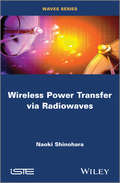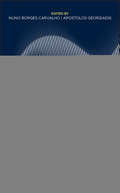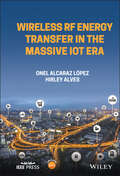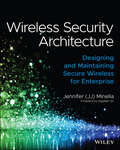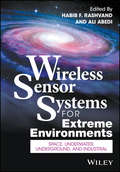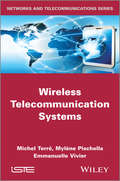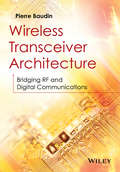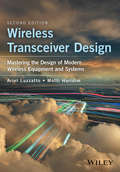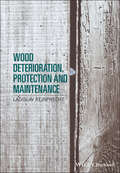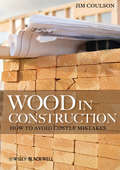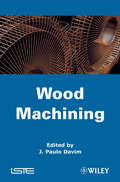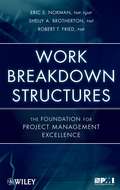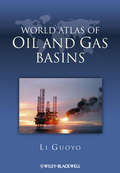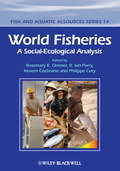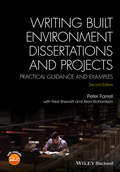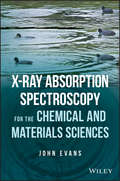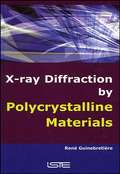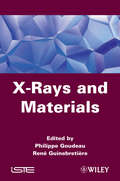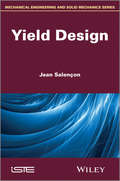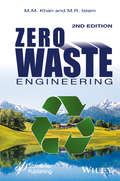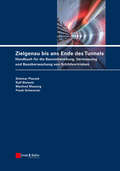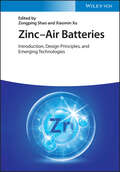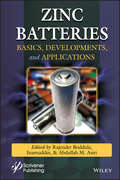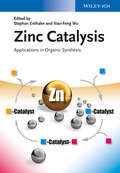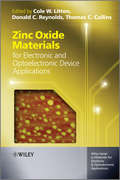- Table View
- List View
Wireless Power Transfer via Radiowaves (Wiley-iste Ser.)
by Naoki ShinoharaRecent advances in Wireless Power Transmission (WPT) technologies have enabled various engineering applications with potential product implementation. WPT can be utilized to charge batteries in various pieces of equipment without the need for a wired connection. Energy can be harvested from ambient RF and microwave radiation and 1 million kW microwaves can be transmitted from space to the ground.This book covers all the theory and technologies of WPT, such as microwave generators with semi-conductors and microwave tubes, antennas, phased arrays, beam efficiency, and rectifiers (rectenna). The authors also discuss coupling WPT. Applications, such as energy harvesting, sensor networks, point-to-point WPT, WPT to moving targets (airplane, vehicle, etc.) and Solar Power Satellite are also presented.
Wireless Power Transmission for Sustainable Electronics: COST WiPE - IC1301
by Nuno Borges CarvalhoProvides a collection of works produced by COST Action IC1301 with the goal of achieving significant advances in the field of wireless power transmission This book constitutes together information from COST Action IC1301, a group of academic and industry experts seeking to align research efforts in the field of wireless power transmission (WPT). It begins with a discussion of backscatter as a solution for Internet of Things (IoT) devices and goes on to describe ambient backscattering sensors that use FM broadcasting for low cost and low power wireless applications. The book also explores localization of passive RFID tags and augmented tags using nonlinearities of RFID chips. It concludes with a review of methods of electromagnetic characterization of textile materials for the development of wearable antennas. Wireless Power Transmission for Sustainable Electronics: COST WiPE - IC1301 covers textile-supported wireless energy transfer, and reviews methods for the electromagnetic characterization of textile materials for the development of wearable antennas. It also looks at: backscatter RFID sensor systems for remote health monitoring; simultaneous localization (of robots and objects) and mapping (SLAM); autonomous system of wireless power distribution for static and moving nodes of wireless sensor networks; and more. Presents techniques for smart beam-forming for "on demand" wireless power transmission (WPT) Discusses RF and microwave energy harvesting for space applications Describes miniaturized RFID transponders for object identification and sensing Wireless Power Transmission for Sustainable Electronics: COST WiPE - IC1301 is an excellent book for both graduate students and industry engineers involved in wireless communications and power transfer, and sustainable materials for those fields.
Wireless RF Energy Transfer in the Massive IoT Era: Towards Sustainable Zero-energy Networks (IEEE Press)
by Hirley Alves Onel Alcaraz LopezA deep dive into wireless energy transfer technologies for IoT networks In Wireless Energy Transfer: Towards Sustainable Zero-Energy IoT Networks, distinguished researchers Onel L. A. López and Hirley Alves deliver a robust discussion of massive wireless energy transfer and zero-energy, low-cost, Internet of Things networks. Moving beyond the basic theoretical background of the subject, the authors offer a deep analysis of the scenarios and requirements of wireless energy transfer. The book details novel powering schemes recently proposed to face the challenging requirements of the future Internet of Things, as well as a comprehensive review of sustainable IoT wireless networks. Wireless Energy Transfer explains why novel energy efficient solutions will be needed to address the sheer volume of devices currently forecasted to be used in the near future. It explores the challenges technologists and users will face as well as proposed solutions and future research directions. The authors also discuss: Thorough introductions to wireless energy transfer, including energy harvesting sources, radio frequency energy harvesting circuits, efficiency models, and architectures for wireless energy transfer powered IoT networks Comprehensive explorations of ambient radio frequency energy harvesting, including measurement campaigns, energy harvesting hardware prototypes, and performance analysis based on stochastic geometry Practical discussions of efficient schemes for massive wireless energy transfer, including energy beamforming, multi-antenna techniques, and distributed antenna systems Perfect for students and researchers in signal processing, communications, networking, and information theory, Wireless Energy Transfer: Towards Sustainable Zero-Energy IoT Networks will also earn a place in the libraries of students and practitioners in the fields of communication hardware and transceiver design.
Wireless Security Architecture: Designing and Maintaining Secure Wireless for Enterprise
by Jennifer MinellaReduce organizational cybersecurity risk and build comprehensive WiFi, private cellular, and IOT security solutions Wireless Security Architecture: Designing and Maintaining Secure Wireless for Enterprise offers readers an essential guide to planning, designing, and preserving secure wireless infrastructures. It is a blueprint to a resilient and compliant architecture that responds to regulatory requirements, reduces organizational risk, and conforms to industry best practices. This book emphasizes WiFi security, as well as guidance on private cellular and Internet of Things security. Readers will discover how to move beyond isolated technical certifications and vendor training and put together a coherent network that responds to contemporary security risks. It offers up-to-date coverage—including data published for the first time—of new WPA3 security, Wi-Fi 6E, zero-trust frameworks, and other emerging trends. It also includes: Concrete strategies suitable for organizations of all sizes, from large government agencies to small public and private companies Effective technical resources and real-world sample architectures Explorations of the relationships between security, wireless, and network elements Practical planning templates, guides, and real-world case studies demonstrating application of the included conceptsPerfect for network, wireless, and enterprise security architects, Wireless Security Architecture belongs in the libraries of technical leaders in firms of all sizes and in any industry seeking to build a secure wireless network.
Wireless Sensor Systems for Extreme Environments: Space, Underwater, Underground and Industrial
by Ali Abedi Habib F. RashvandProvides unique coverage of wireless sensor system applications in space, underwater, underground, and extreme industrial environments in one volume This book covers the challenging aspects of wireless sensor systems and the problems and conditions encountered when applying them in outer space, under the water, below the ground, and in extreme industrial environments. It explores the unique aspects of designs and solutions that address those problems and challenges, and illuminates the connections, similarities, and differences between the challenges and solutions in those various environments. The creation of Wireless Sensor Systems for Extreme Environments is a response to the spread of wireless sensor technology into fields of health, safety, manufacturing, space, environmental, smart cities, advanced robotics, surveillance, and agriculture. It is the first of its kind to present, in a single reference, the unique aspects of wireless sensor system design, development, and deployment in such extreme environments—and to explore the similarities and possible synergies between them. The application of wireless sensor systems in these varied environments has been lagging dramatically behind their application in more conventional environments, making this an especially relevant book for investigators and practitioners in all of these areas. Wireless Sensor Systems for Extreme Environments is presented in five parts that cover: Wireless Sensor Systems for Extreme Environments—Generic Solutions Space WSS Solutions and Applications Underwater and Submerged WSS Solutions Underground and Confined Environments WSS Solutions Industrial and Other WSS Solutions This book is a welcome guide for researchers, post-graduate students, engineers and scientists who design and build operational and environmental control systems, emergency response systems, and situational awareness systems for unconventional environments.
Wireless Telecommunication Systems
by Michel Terré Mylène Pischella Emmanuelle VivierWireless telecommunication systems generate a huge amount of interest. In the last two decades, these systems have experienced at least three major technological leaps, and it has become impossible to imagine how society was organized without them. In this book, we propose a macroscopic approach on wireless systems, and aim at answering key questions about power, data rates, multiple access, cellular engineering and access networks architectures. We present a series of solved problems, whose objective is to establish the main elements of a global link budget in several radiocommunications systems. Contents 1. Radio Propagation. 2. F/TDMA and GSM. 3. CDMA and UMTS. 4. OFDM and LTE. 5. MIMO and Beamforming. 6. UWB. 7. Synchronization. 8. Digital Communications Fundamentals. 9. Erlang B Tables. About the Authors Michel Terré received his engineering degree from Télécom SudParis, his phD in electronics and telecommunications from Conservatoire National des Arts et Métiers (CNAM), and his habilitation to conduct researches from Paris XIII University. He is a full professor at Conservatoire National des Arts et Métiers. He his responsabile of CNAM’s Master of Science in radiocommunicationssystems. Mylène Pischella received her engineering degree and her phD in electronics and telecommunications from Télécom ParisTech. She is an associate professor at Conservatoire National des Arts et Métiers (CNAM). Emmanuelle Vivier received her engineering degree from Institut Supérieur d’Electronique de Paris (ISEP) and her PhD in radiocommunications from Conservatoire National des Arts et Métiers (CNAM). She is an associate professor at ISEP, where she is responsible of networks and telecommunications teaching majors.
Wireless Transceiver Architecture: Bridging RF and Digital Communications
by Pierre BaudinA fully comprehensive reference combining digital communications and RFIC (Radio Frequency Integrated Circuits) in one complete volume There are many books which focus on the physical implementation of the RF/analog part of transceivers, such as the CMOS design, or the signal processing involved in digital communications. However, there islittle material dedicated to transceiver architecture and system design. Similarly, much of the existing literature looks at concepts useful for dimensioning, yet offers little practical information on how to proceed for dimensioning a line-up from scratch, and on the reasons for proceeding that way. This book redresses the balance by explaining the architecture of transceivers and their dimensioning from the perspective of a RFIC architect from within industry. It bridges the gap between digital communication systems and radiofrequency integrated circuit design, covering wireless transceiver architecture and system design from both system level and circuit designer aspects. • Covers digital communication theory, electromagnetism theory and wireless networks organization, from theories to implementation, for deriving the minimum set of constraints to be fulfilled by transceivers • Details the limitations in the physical implementation of transceivers to be considered for their dimensioning, in terms of noise, nonlinearity, and RF impairments • Presents transceiver architecture and system design in terms of transceivers budgets, transceivers architectures, and algorithms for transceivers
Wireless Transceiver Design: Mastering the Design of Modern Wireless Equipment and Systems
by Motti Haridim Ariel LuzzattoBuilding upon the success of the first edition (2007), Wireless Transceiver Design 2nd Edition is an accessible textbook that explains the concepts of wireless transceiver design in detail. The architectures and the detailed design of both traditional and advanced all-digital wireless transceivers are discussed in a thorough and systematic manner, while carefully watching out for clarity and simplicity. Many practical examples and solved problems at the end of each chapter allow students to thoroughly understand the mechanisms involved, to build confidence, and enable them to readily make correct and practical use of the applicable results and formulas. From the instructors' perspective, the book will enable the reader to build courses at different levels of depth, starting from the basic understanding, whilst allowing them to focus on particular elements of study. In addition to numerous fully-solved exercises, the authors include actual exemplary examination papers for instructors to use as a reference format for student evaluation. The new edition has been adapted with instructors/lecturers, graduate/undergraduate students and RF engineers in mind. Non-RF engineers looking to acquire a basic understanding of the main related RF subjects will also find the book invaluable.
Wood Deterioration, Protection and Maintenance
by Ladislav ReinprechtWood Deterioration, Protection and Maintenance provides an up to date discussion of the natural durability of wood, wood degradation processes, and methods of structural and chemical protection of wood. Modern active substances in wood preservatives and the relationships between preservative properties, the anatomical structure and moisture content of wood and protective processes involving pressure and/or diffusion driving forces are fully illustrated.
Wood in Construction: How to Avoid Costly Mistakes
by Jim CoulsonWood in Construction – How to Avoid Costly Mistakes focuses on the basic principles and appropriate use of wood in construction and illustrates how to avoid or minimise problems, to ensure that wood performs as expected when used in a construction application. Based on the author’s extensive experience of manufacturing processes and practical applications in the timber, construction, joinery, shop-fitting and furniture industries, Wood in Construction provides a guide to using wood in building in the real world. It describes the main causes of difficulty when using wood, and shows how to avoid or minimise problems, reducing the difficulties for the architect, engineer or specifier, builder and building owner. Technical enough to explain why things should be done in specific ways, but also practical enough to demonstrate how to use wood correctly and avoid doing the wrong things, this is an invaluable resource for construction specifiers (architects, engineers), carpenters, structural engineers, building surveyors, small/medium sized builders.
Wood Machining
by J. Paulo DavimWood as an engineering material can be technically defined “as a hygroscopic, orthotropic, biological, and permeable material having extreme chemical diversity and physical complexity with structures, that vary extensively in their shape, size, properties and function”. Therefore, using wood to its best advantage and most efficiency in engineering applications, specific characteristics or chemical, physical and mechanical properties must be considered. The products are divided into two classes, solid wood and composite wood products. Solid wood includes shipbuilding, bridges, flooring, mine timbers, etc. Composite wood products include insulation board, plywood, oriented strand board, hardboard and particle board. In recent years, the machining of wood products has acquired great importance due the short supply of wood and increasing environmental awareness among users and manufacturers. The optimization of the machining process centers around the mechanism of chip formation, tool wear, workpiece surface quality, crack initiation and propagation of different types of wood. Other factors are also humidity, temperature, static preloads, and vibrations that can affect the wood during the machining process. The book provides some fundamentals and recent research advances on machining wood and wood products.
Work Breakdown Structures
by Robert T. Fried Shelly A. Brotherton Eric S. NormanUnderstand and apply new concepts regarding Work Breakdown StructuresThe Work Breakdown Structure (WBS) has emerged as a foundational concept and tool in Project Management. It is an enabler that ensures clear definition and communication of project scope while performing a critical role as a monitoring and controlling tool. Created by the three experts who led the development of PMI's Practice Standard for Work Breakdown Structures, Second Edition, this much-needed text expands on what the standard covers and describes how to go about successfully implementing the WBS within the project life cycle, from initiation and planning through project closeout.Filling the gap in the literature on the WBS, Work Breakdown Structures: The Foundation for Project Management Excellence gives the reader an understanding of:The background and key concepts of the WBSWBS core characteristics, decomposition, representations, and toolsProject initiation and the WBS, including contracts, agreements, and Statements of Work (SOW)Deliverable-based and activity-based managementUsing the WBS as a basis for procurement and financial planningQuality, risk, resource, and communication planning with the WBSThe WBS in the executing, monitoring, and controlling phasesNew concepts regarding the representation of project and program scopeVerifying project closeout with the WBSUsing a real-life project as an example throughout the book, the authors show how the WBS first serves to document and collect information during the initiating and planning phases of a project. Then, during the executing phase, the authors demonstrate how the WBS transitions to an active role of project decision-support, serving as a reference and a source for control and measurement.
World Atlas of Oil and Gas Basins
by Guoyu LiProfessor Li’s World Atlas of Oil and Gas Basins is a fresh and comprehensive treatise of the distribution of the world’s hydrocarbon reserves. The Atlas highlights the geographical, sedimentary and geological features of the basins, using a combination of maps and stratigraphic diagrams to depict the history, prospectivity and commercial production capacity of the reserves on a continental and country-by-country basis. The Atlas is an essential reference source for petroleum geologists and reservoir engineers working in hydrocarbon exploration and production. It is also a valuable and original teaching aid for university graduate and postgraduate courses. The Atlas provides a welcome addition to the global database of the world’s energy resources and is therefore an indispensable source of information for the formulation of future strategies to exploit oil and gas reserves. Written by one of China’s foremost petroleum geologists, the Atlas provides a rare analysis of the industry from the perspective of the country whose demand for oil and gas is set to become the largest in the next few decades. It is an important and vital scholarly work.
World Fisheries: A Social-Ecological Analysis (Fish And Aquatic Resources Ser.)
by Rosemary Ommer Ian Perry Kevern L. Cochrane Philippe CuryThis exciting new book grew out of an international symposium held at FAO, Rome in July 2008, but it is not just a collection of papers from that symposium. Rather, the publication brings together work on social-ecological marine research that cuts across disciplines, identifies key common elements and approaches that promote resilience of marine social-ecological systems in the face of global changes, and points to next steps. The book comprises contributions on conceptual issues relating to social-ecological responses in marine systems to global changes; offers illustrative case studies of specific examples of social-ecological responses in marine systems to significant environmental changes manifested locally; develops a syntheses between natural and social scientists on the topic, and points the way forward with innovative approaches to the use of science and knowledge in management, policy and advice. World Fisheries is part of Wiley-Blackwell's prestigious Fish and Aquatic Resources Series, and encompasses chapters from many scientists at the top of their fields worldwide. Carefully drawn together and edited by four world experts in the area, World Fisheries is a landmark publication which is an essential purchase for all fisheries managers worldwide.
Writing Built Environment Dissertations and Projects: Practical Guidance and Examples
by Fred Sherratt Alan Richardson Peter FarrellWriting Built Environment Dissertations and Projects will help you to write a good dissertation or project by giving you a good understanding of what should be included, and showing you how to use data collection and analysis tools in the course of your research. Addresses prominent weaknesses in under-graduate dissertations including weak data collection; superficial analysis and poor reliability and validity Includes many more in-depth examples making it easy to understand and assimilate the concepts presented Issues around study skills and ethics are embedded throughout the book and the many examples encourage you to consider the concepts of reliability and validity Second edition includes a new chapter on laboratory based research projects Supporting website with sample statistical calculations and additional examples from a wider range of built environment subjects
X-ray Absorption Spectroscopy for the Chemical and Materials Sciences
by John EvansA clear-cut introduction to the technique and applications of x-ray absorption spectroscopy X-ray Absorption Spectroscopy is being applied to a widening set of disciplines. Applications started with solid state physics and grew to materials science, chemistry, biochemistry and geology. Now, they cut across engineering materials, environmental science and national heritage — providing very detailed and useful information facilitating understanding and development of materials. This practical guide helps investigators choose the right experiment, carry it out properly and analyze the data to give the best reliable result. It gives readers insights to extract what they need from the world of large-scale experimental facilities like synchrotrons, which seem distant to many laboratory scientists. X-ray Absorption Spectroscopy for the Chemical and Materials Sciences seeks to educate readers about the strengths and limitations of the techniques, including their accessibility. Presented in six sections, it offers chapters that cover: an introduction to X-ray absorption fine structure XAFS; the basis of XAFS; X-ray sources; experimental methods; data analysis and simulation methods; and case studies. A no-nonsense introduction to the technique and applications of x-ray absorption spectroscopy Features Questions to support learning through the book Relevant to all working on synchrotron sources and applications in physics, materials, environment/geology and biomedical materials Four-color representation allows easy interpretation of images and data for the reader X-ray Absorption Spectroscopy for the Chemical and Materials Sciences is aimed at Masters-level and PhD students embarking on X-ray spectroscopy projects as well as scientists in areas of materials characterization.
X-Ray Diffraction by Polycrystalline Materials
by René GuinebretièreThis book presents a physical approach to the diffraction phenomenon and its applications in materials science. An historical background to the discovery of X-ray diffraction is first outlined. Next, Part 1 gives a description of the physical phenomenon of X-ray diffraction on perfect and imperfect crystals. Part 2 then provides a detailed analysis of the instruments used for the characterization of powdered materials or thin films. The description of the processing of measured signals and their results is also covered, as are recent developments relating to quantitative microstructural analysis of powders or epitaxial thin films on the basis of X-ray diffraction. Given the comprehensive coverage offered by this title, anyone involved in the field of X-ray diffraction and its applications will find this of great use.
X-Rays and Materials
by Philippe Goudeau René GuinebretièreThis book presents reviews of various aspects of radiation/matter interactions, be these instrumental developments, the application of the study of the interaction of X-rays and materials to a particular scientific field, or specific methodological approaches. The overall aim of the book is to provide reference summaries for a range of specific subject areas within a pedagogical framework. Each chapter is written by an author who is well known within their field and who has delivered an invited lecture on their subject area as part of the “RX2009 – X-rays and Materials” colloquium that took place in December 2009 at Orsay in France. The book consists of five chapters on the subject of X-ray diffraction, scattering and absorption. Chapter 1 gives a detailed presentation of the capabilities and potential of beam lines dedicated to condensed matter studies at the SOLEIL synchrotron radiation source. Chapter 2 focuses on the study of nanoparticles using small-angle X-ray scattering. Chapter 3 discusses the quantitative studies of this scattering signal used to analyze these characteristics in detail. Chapter 4 discusses relaxor materials, which are ceramics with a particularly complex microstructure. Chapter 5 discusses an approach enabling the in situ analysis of these phase transitions and their associated microstructural changes.
Yield Design
by Jean SalençonSince the middle of the 20th Century yield design approaches have been identified with the lower and upper bound theorem of limit analysis theory – a theory associated with perfect plasticity. This theory is very restrictive regarding the applicability of yield design approaches, which have been used for centuries for the stability of civil engineering structures. This book presents a theory of yield design within the original “equilibrium/resistance” framework rather than referring to the theories of plasticity or limit analysis; expressing the compatibility between the equilibrium of the considered structure and the resistance of its constituent material through simple mathematical arguments of duality and convex analysis results in a general formulation, which encompasses the many aspects of its implementation to various stability analysis problems. After a historic outline and an introductory example, the general theory is developed for the three-dimensional continuum model in a versatile form based upon simple arguments from the mathematical theory of convexity. It is then straightforwardly transposed to the one-dimensional curvilinear continuum, for the yield design analysis of beams, and the two-dimensional continuum model of plates and thin slabs subjected to bending. Field and laboratory observations of the collapse of mechanical systems are presented along with the defining concept of the multi-parameter loading mode. The compatibility of equilibrium and resistance is first expressed in its primal form, on the basis of the equilibrium equations and the strength domain of the material defined by a convex strength criterion along with the dual approach in the field of potentially safe loads, as is the highlighting of the role implicitly played by the theory of yield design as the fundamental basis of the implementation of the ultimate limit state design (ULSD) philosophy with the explicit introduction of resistance parameters. Contents 1. Origins and Topicality of a Concept. 2. An Introductory Example of the Yield Design Approach. 3. The Continuum Mechanics Framework. 4. Primal Approach of the Theory of Yield Design. 5. Dual Approach of the Theory of Yield Design. 6. Kinematic Exterior Approach. 7. Ultimate Limit State Design from the Theory of Yield Design. 8. Optimality and Probability Approaches of Yield Design. 9. Yield Design of Structures. 10. Yield Design of Plates: the Model. 11. Yield Design of Plates Subjected to Pure Bending. About the Authors Jean Salençon is Emeritus Professor at École polytechnique and École des ponts et chaussées, ParisTech, France. Since 2009 he has been a member of the Administrative Board of CNRS (Paris, France). He has received many awards including the Légion d’Honneur (Commander), Ordre National du Mérite (Officer) and Palmes Académiques (Commander). His research interests include structure analysis, soil mechanics and continuum mechanics.
Zero Waste Engineering: A New Era of Sustainable Technology Development (Wiley-Scrivener #82)
by M. M. Khan M. R. IslamIs "zero waste engineering" possible? This book outlines how to achieve zero waste engineering, following natural pathways that are truly sustainable. Using methods that have been developed in various areas for sustainability purposes, such as new mathematical models, recyclable material selection, and renewable energy, the authors probe the principles of zero waste engineering and how it can be applied to construction, energy production, and many other areas of engineering. This groundbreaking new volume: Explores new scientific principles on which sustainability and zero waste engineering can be based Presents new models for energy efficiency, cooling processes, and natural chemical and material selection in industrial applications and business Explains how "green buildings" and "green homes" can be efficiently built and operated with zero waste Offers case histories and successful experiments in sustainability and zero-waste engineering Ideal for: Engineers and scientists of all industries, including the energy industry, construction, the process industries, and manufacturing. Chemical engineers, mechanical engineers, electrical engineers, petroleum engineers, process engineers, civil engineers, and many other types of engineers would all benefit from reading this exciting new volume.
Zielgenau bis ans Ende des Tunnels: Handbuch fur die Bauvorbereitung, Vermessung und Bauuberwachung von Schildvortrieben
by Dietmar Placzek Rolf Bielecki Manfred Messing Frank SchwarzerDamit der fertige Tunnel am Ende seine Funktion erfüllen kann, muss er exakt so liegen, wie er geplant wurde. Einfluss auf die Vortriebsgenauigkeit haben Trassen- und Gradientenplanung, Baugrund- und Grundwasserverhältnisse, das gewählte Vortriebsverfahren, Einwirkungen und Widerstände auf die Vortriebsmaschine sowie die begleitende Bauüberwachung und Kontrolle. Das Handbuch ist Grundlage für die Bauvorbereitung, die Vermessung und Bauüberwachung von Schildvortrieben und gilt gleichermaßen für Rohr- und Tübbingvortriebe, die mit gesteuerten Schildmaschinen durchgeführt werden. Bauherren, Planer, Prüfer und Ausführenden werden dieses Handbuch als technischen Leitfaden für einen sicheren und zielgenauen Vortrieb nutzen. Das Buch ist darüber hinaus auch als Lehrbuch im Rahmen der Aus- und Weiterbildung geeignet.
Zinc-Air Batteries: Introduction, Design Principles, and Emerging Technologies
by Zongping Shao Xiaomin XuZinc–Air Batteries Authoritative and comprehensive resource covering foundational knowledge of zinc–air batteries as well as their practical applications Zinc–Air Batteries provides a comprehensive understanding of the history and development of Zn–air batteries, with a systematic overview of components, design, and device innovation, along with recent advances in the field, especially with regards to the cathode catalyst design made by cutting-edge materials, engineering processes, and technologies. In particular, design principles regarding the key components of Zn–air batteries, ranging from air cathode, to zinc anode, and to electrolyte, are emphasized. Furthermore, industrial developments of Zn–air batteries are discussed and emerging new designs of Zn–air batteries are also introduced. The authors argue that designing advanced Zn–air battery technologies is important to the realization of efficient energy storage and conversion—and, going further, eventually holds the key to a sustainable energy future and a carbon-neutral goal. Edited and contributed to by leading professionals and researchers in the field, Zinc–Air Batteries also contains information regarding: Design of oxygen reduction catalysts in primary zinc–air batteries, including precious metals, single-atoms, carbons, and transition metal oxides Design of bifunctional oxygen catalysts in rechargeable zinc–air batteries, covering specific oxygen redox reactions and catalyst candidates Design of three-dimensional air cathode in zinc–air batteries, covering loading of carbon-based and transition metal catalysts, plus design of the three-phase interface Design of electrolyte for zinc–air batteries, including liquid electrolytes (e.g., alkaline) and gel polymer electrolytes (e.g., PVA hydrogel) For students, researchers, and instructors working in battery technologies, materials science, and electrochemistry, and for industry and government representatives for decision making associated with energy and transportation, Zinc–Air Batteries summarizes the research results on Zn–air batteries and thereby helps researchers and developers to implement the technology in practice.
Zinc Batteries: Basics, Developments, and Applications
by Rajender Boddula Inamuddin Abdullah M. AsiriBattery technology is constantly changing, and the concepts and applications of these changes are rapidly becoming increasingly more important as more and more industries and individuals continue to make “greener” choices in their energy sources. As global dependence on fossil fuels slowly wanes, there is a heavier and heavier importance placed on cleaner power sources and methods for storing and transporting that power. Battery technology is a huge part of this global energy revolution. Zinc batteries are an advantageous choice over lithium-based batteries, which have dominated the market for years in multiple areas, most specifically in electric vehicles and other battery-powered devices. Zinc is the fourth most abundant metal in the world, which is influential in its lower cost, making it a very attractive material for use in batteries. Zinc-based batteries have been around since the 1930s, but only now are they taking center stage in the energy, automotive, and other industries. Zinc Batteries: Basics, Developments, and Applicationsis intended as a discussion of the different zinc batteries for energy storage applications. It also provides an in-depth description of various energy storage materials for Zinc (Zn) batteries. This book is an invaluable reference guide for electrochemists, chemical engineers, students, faculty, and R&D professionals in energy storage science, material science, and renewable energy.
Zinc Catalysis
by Xiao-Feng Wu Stephan EnthalerFilling the gap in the market for comprehensive coverage of this hot topic, this timely book covers a wide range of organic transformations, e. g. reductions of unsaturated compounds, oxidation reactions, Friedel-Crafts reactions, hydroamination reactions, depolymerizations, transformations of carbon dioxide, oxidative coupling reactions, as well as C-C, C-N, and C-O bond formation reactions. A chapter on the application of zinc catalysts in total synthesis is also included. With its aim of stimulating further research and discussion in the field, this is a valuable reference for professionals in academia and industry wishing to learn about the latest developments.
Zinc Oxide Materials for Electronic and Optoelectronic Device Applications
by Cole W. Litton Thomas C. Collins Donald C. Reynolds Arthur Willoughby Peter Capper Safa KasapZinc Oxide (ZnO) powder has been widely used as a white paint pigment and industrial processing chemical for nearly 150 years. However, following a rediscovery of ZnO and its potential applications in the 1950s, science and industry alike began to realize that ZnO had many interesting novel properties that were worthy of further investigation.ZnO is a leading candidate for the next generation of electronics, and its biocompatibility makes it viable for medical devices. This book covers recent advances including crystal growth, processing and doping and also discusses the problems and issues that seem to be impeding the commercialization of devices.Topics include:Energy band structure and spintronics Fundamental optical and electronic properties Electronic contacts of ZnO Growth of ZnO crystals and substrates Ultraviolet photodetectors ZnO quantum wells Zinc Oxide Materials for Electronic and Optoelectronic Device Applications is ideal for university, government, and industrial research and development laboratories, particularly those engaged in ZnO and related materials research.
